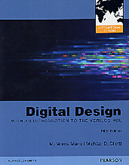Introduction to Logic Design, 3/e (IE-Paperback)
暫譯: 邏輯設計導論 (第三版)
Alan B Marcovitz
- 出版商: McGraw-Hill Education
- 定價: $1,600
- 售價: 9.8 折 $1,568
- 語言: 英文
- 頁數: 672
- 裝訂: Paperback
- ISBN: 9814646652
- ISBN-13: 9789814646659
-
相關分類:
邏輯設計 Logic-design
-
其他版本:
Introduction to Logic Design, 3/e (Hardcover)
立即出貨
買這商品的人也買了...
-
 玩轉 AIoT 智慧物聯網-智慧居家動手做 (學AI真簡單系列5)
玩轉 AIoT 智慧物聯網-智慧居家動手做 (學AI真簡單系列5)$280$252 -
 AIoT 智慧物聯網應用實習 - 使用 Arduino C 程式語言結合 ESP32-CAM 開發板:附 MOSME 行動學習一點通:診斷.加值
AIoT 智慧物聯網應用實習 - 使用 Arduino C 程式語言結合 ESP32-CAM 開發板:附 MOSME 行動學習一點通:診斷.加值$520$468 -
 簡報美學|簡報x設計x呈現
簡報美學|簡報x設計x呈現$520$411 -
 簡報技術圖解:抓住五大必勝因素、100個簡報必備訣竅,任何提案都能輕鬆過關!
簡報技術圖解:抓住五大必勝因素、100個簡報必備訣竅,任何提案都能輕鬆過關!$350$298 -
 現代電子產品的核心 — 半導體與量子物理原來這麼簡單!
現代電子產品的核心 — 半導體與量子物理原來這麼簡單!$660$521 -
 PowerPoint 必勝簡報 原則154:「提案型」╳「分析型」兩類簡報一次攻克!【暢銷慶功版】
PowerPoint 必勝簡報 原則154:「提案型」╳「分析型」兩類簡報一次攻克!【暢銷慶功版】$490$417 -
 IoT 物聯網應用 - 使用 ESP32 開發板與 Arduino C 程式語言 - 最新版 (第三版) - 附 MOSME 行動學習一點通:評量、加值
IoT 物聯網應用 - 使用 ESP32 開發板與 Arduino C 程式語言 - 最新版 (第三版) - 附 MOSME 行動學習一點通:評量、加值$450$405 -
 世界第1強 AI ChatGPT Turbo 自學魔法寶典- Data Analyst +GPTs + DALL-E + Copilot + Prompt +Midjourney + Suno + D-ID + Runway + Gamma (頂級雪銅紙全彩印刷版)
世界第1強 AI ChatGPT Turbo 自學魔法寶典- Data Analyst +GPTs + DALL-E + Copilot + Prompt +Midjourney + Suno + D-ID + Runway + Gamma (頂級雪銅紙全彩印刷版)$699$552
相關主題
商品描述
Description Introduction to Logic Design by Alan Marcovitz is intended for the first course in logic design, taken by computer science, computer engineering, and electrical engineering students. As with the previous editions, this edition has a clear presentation of fundamentals and an exceptional collection of examples, solved problems and exercises. The text integrates laboratory experiences, both hardware and computer simulation, while not making them mandatory for following the main flow of the chapters. Design is emphasized throughout, and switching algebra is developed as a tool for analyzing and implementing digital systems. The presentation includes excellent coverage of minimization of combinational circuits, including multiple output ones, using the Karnaugh map and iterated consensus. There are a number of examples of the design of larger systems, both combinational and sequential, using medium scale integrated circuits and programmable logic devices. The third edition features two chapters on sequential systems. The first chapter covers analysis of sequential systems and the second covers design. Complete coverage of the analysis and design of synchronous sequential systems adds to the comprehensive nature of the text. The derivation of state tables from word problems further emphasizes the practical implementation of the material being presented.
Features All of the K-Map (Karnaugh map) coverage is presented in one chapter (chapter 3) instead of coverage appearing in two chapters. For the third edition, Chapter 9 will be posted on the website. This allows for additional coverage of other topics without increasing the length of the text. Additional experiments have been added to Appendix D to allow students the opportunity to perform a variety of experiments. New Appendix A (Relating the Algebra to the Karnaugh Map) ties algebra coverage and K-Map coverage together. New problems have been added in Appendix E for both combinational and sequential systems which go from word problem to circuit all in one place. An extensive set of examples, well integrated into the body of the text as well as at the end of each chapter in sections of solved problems, gives students multiple opportunities to understand the topics being presented. A feature of this text is the Solved Problems. Each chapter has a large number of problems, illustrating the techniques developed in the body of the text, followed by a detailed solution of each problem. Each chapter contains a large set of exercises. Answers to a selection of these are contained in Appendix B. Solutions are made available to instructors on the website. Iterated Consensus and Quine-McCluskey coverage is included in the third edition. The third edition features two chapters on sequential systems. The first chapter covers analysis of sequential systems and the second covers design. Complete coverage of the analysis and design of synchronous sequential systems adds to the comprehensive nature of the text. A clear and well-paced writing style makes this text especially well-suited for students who might otherwise find this course area particularly challenging. The text integrates practical circuits with theory by presenting two types of laboratory experiments. Traditional hands-on hardware experiments as well as simulation laboratory exercises using popular software packages are tied closely to the text material to allow students to implement the concepts they are learning. Use of the Karnaugh map helps students understand the principles of switching algebra. A thorough discussion of the minimization of switching functions using Karnaugh maps, including 6-variable maps and multiple output problems, gives students something to sink their teeth into and doesn't leave them wondering about the unusual or boundary case. Coupling of gate implementation with the algebra helps extend the students' range of understanding. Color is used as a pedagogical aid. The derivation of state tables from word problems further emphasizes the practical implementation of the material being presented.
Table of Contents 1 Introduction 2 Combinational Systems 3 The Karnaugh Map 4 Function Minimization Algorithms 5 Designing Combinational Systems 6 Analysis of Sequential Systems 7 The Design of Sequential Systems 8 Solving Larger Sequential Problems 9 Simplification of Sequential Circuits Appendix A Relating the Algebra to the Karnaugh Map Appendix B Answers to Selected Exercises Appendix C Chapter Tests Answers Appendix D Laboratory Experiments Appendix E Complete Examples
商品描述(中文翻譯)
描述 《邏輯設計導論》由 Alan Marcovitz 所著,旨在為計算機科學、計算機工程和電機工程學生提供邏輯設計的第一門課程。與之前的版本一樣,本版清晰地呈現了基本概念,並提供了卓越的範例、已解決的問題和練習。文本整合了硬體和計算機模擬的實驗經驗,但不強制要求學生必須跟隨章節的主要流程。設計在整個過程中被強調,並將開關代數發展為分析和實現數位系統的工具。內容包括對組合電路最小化的優秀覆蓋,包括使用卡諾圖(Karnaugh map)和迭代共識的多輸出電路。還有一些設計較大系統的範例,包括使用中等規模集成電路和可編程邏輯設備的組合和序列系統。第三版包含兩章有關序列系統的內容。第一章涵蓋序列系統的分析,第二章則涵蓋設計。對同步序列系統的分析和設計的完整覆蓋,增強了文本的全面性。從文字問題推導狀態表進一步強調了所呈現材料的實際應用。
特點 所有的 K-Map(卡諾圖)內容都集中在一章(第3章)中,而不是分散在兩章中。對於第三版,第9章將在網站上發布。這樣可以在不增加文本長度的情況下,對其他主題進行額外的覆蓋。附錄 D 中增加了額外的實驗,讓學生有機會進行各種實驗。新的附錄 A(將代數與卡諾圖相關聯)將代數內容和 K-Map 覆蓋結合在一起。附錄 E 中新增的問題涵蓋了組合和序列系統,從文字問題到電路的解決方案都集中在一個地方。大量的範例,良好地融入文本主體以及每章結尾的已解決問題部分,為學生提供了多次理解所呈現主題的機會。本書的一個特點是已解決的問題。每章都有大量問題,說明了文本主體中發展的技術,並附有每個問題的詳細解答。每章包含大量練習題。這些練習題的部分答案在附錄 B 中提供。解答將在網站上提供給教師。第三版中包含了迭代共識和 Quine-McCluskey 的內容。第三版包含兩章有關序列系統的內容。第一章涵蓋序列系統的分析,第二章則涵蓋設計。對同步序列系統的分析和設計的完整覆蓋,增強了文本的全面性。清晰且節奏良好的寫作風格使本書特別適合那些可能會覺得這一課程領域特別具挑戰性的學生。文本通過呈現兩種類型的實驗,將實際電路與理論相結合。傳統的實體硬體實驗以及使用流行軟體包的模擬實驗緊密結合文本材料,使學生能夠實施他們所學的概念。使用卡諾圖幫助學生理解開關代數的原則。對使用卡諾圖最小化開關函數的徹底討論,包括 6 變數圖和多輸出問題,讓學生能夠深入理解,而不會對不尋常或邊界情況感到困惑。將閘實現與代數相結合,有助於擴展學生的理解範圍。顏色被用作教學輔助工具。從文字問題推導狀態表進一步強調了所呈現材料的實際應用。
目錄 1 引言 2 組合系統 3 卡諾圖 4 函數最小化算法 5 設計組合系統 6 序列系統的分析 7 序列系統的設計 8 解決較大序列問題 9 序列電路的簡化 附錄 A 將代數與卡諾圖相關聯 附錄 B 選定練習題的答案 附錄 C 章節測試答案 附錄 D 實驗 附錄 E 完整範例































